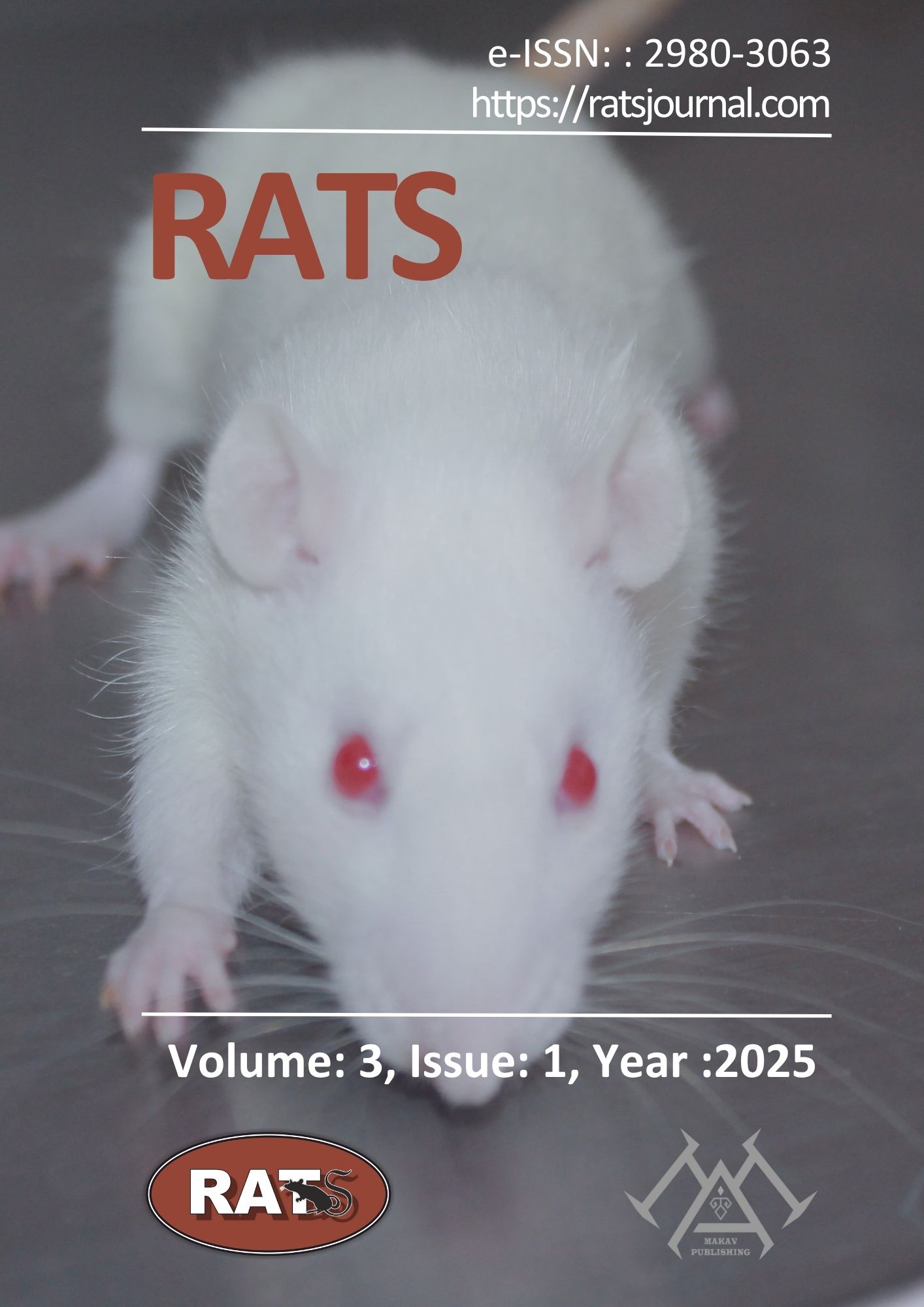The clinical significance of symmetric dimethylarginine in laboratory animals
DOI:
https://doi.org/10.5281/zenodo.15767515Keywords:
Laboratory animals, symmetric dimethylarginine, renal biomarkers, preclinical researchAbstract
Symmetric dimethylarginine (SDMA) has emerged as an important biomarker for assessing kidney function, offering higher sensitivity and specificity compared to traditional biomarkers such as creatinine and blood urea nitrogen (BUN). This review explores the clinical significance of SDMA in laboratory animals, its role in preclinical research, and its translational applications. A byproduct of protein turnover, SDMA is primarily excreted via the kidneys and serves as a reliable indicator of glomerular filtration rate (GFR). Unlike traditional biomarkers, SDMA is minimally affected by extrarenal factors such as muscle mass or systemic conditions, allowing for more accurate kidney function assessment. In preclinical models, particularly in rodents, SDMA has proven effective in detecting early kidney dysfunction and monitoring nephrotoxicity during drug development. Its stability, ease of measurement via enzyme-linked immunosorbent assays (ELISA), and scalability for high-throughput analyses enhance its utility. Comparative studies have consistently shown that SDMA outperforms creatinine and cystatin C, especially in detecting early-stage kidney disease and experimental nephropathy. Furthermore, SDMA’s ability to differentiate between acute and chronic kidney damage strengthens its potential in multi-biomarker panels. Given its translational potential, SDMA serves as a critical bridge between preclinical findings and clinical applications. This review underscores the importance of SDMA in advancing kidney research and improving patient outcomes. The advances in analytical techniques and SDMA’s consistent performance across species position it as a key tool for both preclinical studies and clinical nephrology, enhancing diagnostic accuracy and monitoring kidney health.
References
Abuelo JG. Normotensive ischemic acute renal failure. N Engl J Med. 2007, 357: 797–805
Challiner R, Ritchie JP, Fullwood C, Loughnan P, Hutchison AJ. Incidence and consequence of acute kidney injury in unselected emergency admissions to a large acute UK hospital trust. BMC Nephrol. 2014, 15: 84
Desai AA, Baras J, Berk BB, Nakajima A, Garber AM, Owens D, Chertow GM. Management of acute kidney injury in the intensive care unit: a cost-effectiveness analysis of daily vs alternate-day hemodialysis. Arch Intern Med. 2008, 168: 1761–1767.
Chawla LS, Kimmel PL. Acute kidney injury and chronic kidney disease: an integrated clinical syndrome. Kidney Int. 2012, 82: 516–524
Garg AX, Suri RS, Barrowman N, et al. Long-term renal prognosis of diarrhea-associated hemolytic uremic syndrome: a systematic review, meta-analysis, and meta-regression. JAMA, 2003, 290: 1360–1370
Lo LJ, Go AS, Chertow GM, et al. Dialysis-requiring acute renal failure increases the risk of progressive chronic kidney disease. Kidney Int, 2009, 76: 893–899
Hall JA, Yerramilli M, Obare E, Yerramilli M, Jewell DE: Comparison of serum concentrations of symmetric dimethylarginine and creatinine as kidney function biomarkers in cats with chronic kidney disease. J Vet Intern Med, 2014,28: 1676–1683
Al Banchaabouchi M, Marescau B, Possemiers I, D’Hooge R, Levillain O, De Deyn PP. NG,NG-Dimethylarginine and NG,N’G-dimethylarginine in renal insufficiency. Pflüg Arch. 2000, Mar 1;439(5):524–31
Kielstein JT, Salpeter SR, Bode-Boeger SM, Cooke JP, Fliser D. Symmetric dimethylarginine (SDMA) as endogenous marker of renal function—a meta-analysis. Nephrol Dial Transplant Off Publ Eur Dial Transpl Assoc—Eur Ren Assoc. 2006, Sep;21(9):2446–51
Nabity MB, Lees GE, Boggess MM, et al. Symmetric Dimethylarginine Assay Validation, Stability, and Evaluation as a Marker for the Early Detection of Chronic Kidney Disease in Dogs. J Vet Intern Med. 2015;29(4):1036–44.
Figueroa, M. E., & Rawls, W. E. Biological markers for differentiation of herpes-virus strains of oral and genital origin. J Gen Virol, 1969,4(3), 259–267.
Micheel, C., & Ball, J. R. Evaluation of Biomarkers and Surrogate Endpoints in Chronic Disease. Washington, DC: Institute of Medicine, 2010.
Biomarker Definitions Working Group (DWG). Biomarkers and surrogate endpoints: preferred definitions and conceptual framework. Clin. Pharmacol. Ther, 2001, 69, 89–95.
FDA-NIH Biomarker Working Group. BEST (Biomarkers, EndpointS, and Other Tools) Resource. Bethesda, MD: Food and Drug Administration. Retrieved from, 2016.
Cobrin AR, Blois SL, Kruth SA, Abrams-Ogg AC, Dewey C. Biomarkers in the assessment of acute and chronic kidney diseases in the dog and cat. J Small Anim Pract. 2013;54:647–655.
De Loor J, Daminet S, Smets P, Maddens B, Meyer E. Urinary biomarkers for acute kidney injury in dogs. J Vet Intern Med. 2013;27:998–1010.
Pressler BM. Clinical approach to advanced renal function testing in dogs and cats. Vet Clin North Am Small Anim Pract. 2013;43:1193–1208, v.
Köhler, J., Ott, C., Kuhlmann, M. Renal clearance of dimethylarginines: Implications for biomarker utility. Kidney Int, 2004;65(1), 30–39.
Schwedhelm E, Böger RH: The role of asymmetric and symmetric dimethylarginines in renal disease. Nat Rev Nephrol, 2011;7: 275–285
Garrett, K. R., Johnson, L. P., & Harrison, R. D. SDMA as a marker of renal function: Correlation with GFR. Nephrol. Res, 2011;45(6), 1024–1032.
Müller, D., Tolle, M., & Vanholder, R. Nonrenal factors influencing renal biomarkers. Nephrol. Dial. Transplant, 2015;30(1), 17–22.
Nguyen, H. Q., Parker, B. J., & Liu, Y. Lean body mass and renal biomarker variability. J. Nephrol, 2016;29(4), 531–540.
Cooper, M. E., Maxwell, S. E., & Patel, D. J. Evaluating renal biomarkers: SDMA and Cystatin C. Clin. Nephrol, 2014;82(3), 151–158.
Nguyen, H. Q., Schmidt, A. C., & Brown, D. W. Chronic renal impairment and SDMA levels in animals. Vet. Med. Sci, 2017;3(2), 120–130.
Lopez, E., Meyer, P. R., & Rogers, C. E. Advances in SDMA assays: Proprietary ELISA versus DLD. Vet. Diagn, 2020;8(3), 224–230.
Wasilewska A, Taranta-Janusz K, Zoch-Zwierz W, Michaluk-Skutnik J. Is plasma symmetric dimethylarginine a suitable marker of renal function in children and adolescents? Scand J Urol Nephrol. 2012, Feb 1;46(1):58–64.
Hamlin DM, Schultze AE, Coyne MJ, et al. Evaluation of renal biomarkers, including symmetric dimethylarginine, following gentamicin-induced proximal tubular injury in the rat. Kidney 360, 2022; 3(2), 341-356.
Carello KA, Whitesall SE, Lloyd MC, Billecke SS, D’Alecy LG: Asymmetrical dimethylarginine plasma clearance persists after acute total nephrectomy in rats. Am J Physiol Heart Circ Physiol. 2006; 290: H209–H216
Nijveldt RJ, Teerlink T, van Guldener C, et al. Handling of asymmetrical dimethylarginine and symmetrical dimethylarginine by the rat kidney under basal conditions and during endotoxaemia. Nephrol Dial Transplant. 2003;18: 2542–2550
Chae JW, Baek IH, Kang W, Kwon KI: Simultaneous determination of l-arginine, asymmetric dimethylarginine, and symmetric dimethylarginine in the plasma of rodents with LC-MS/MS. Arzneim. Forsch. 2011;61: 340–346.
Lopez, E., Schmidt, K. E., & Larson, T. A. Effects of chronic SDMA infusion on renal histology. Renal Pathology, 2015;24(3), 312–320.
Meyer, P. R., Schmidt, K. E., & Lopez, E. Scaling SDMA assays for rodent models. Transl. Vet. Sci,2021;4(2), 89–95.
El-Khoury JM, Bunch DR, Hu B, Payto D, Reineks EZ, Wang S: Comparison of symmetric dimethylarginine with creatinine, cystatin C and their eGFR equations as markers of kidney function. Clin Biochem, 2016;49: 1140–1143.
Hall JA, Yerramilli M, Obare E, Yerramilli M, Almes K, Jewell DE: Serum concentrations of symmetric dimethylarginine and creatinine in dogs with naturally occurring chronic kidney disease. J Vet Intern Med, 2016;30: 794–802.
Schmidt, K. E., Meyer, P. R., & Lopez, E. Serum requirements for SDMA testing in animal studies. Veterinary Laboratory Investigations, 2021;15(3), 190–198.
Downloads
Published
How to Cite
Issue
Section
License
Copyright (c) 2025 Rats

This work is licensed under a Creative Commons Attribution 4.0 International License.


















